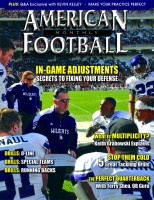Article CategoriesAFM Magazine
|
Speed Report – Multi-Dimensional Movement Speed Before the Season Beginsby: Dale BaskettFootball Speed Specialist © More from this issue The essence of football speed is velocity with control. Many sports require movement changes. However, football is more challenging than other team sports due to the amount of contact during practice and games that other team sports don’t have. Football has multiple requirements. Add the speed and movement factors involved and movement becomes challenging. Good movement positioning and control is the backbone of performance. What makes for an outstanding performance is not solely the level of an athlete’s skill but the level of movement skills that accompany the athlete’s natural ability. Every athlete on your team can and should strive to develop quality movement skills. Here’s how: Multi-Dimensional Movement and Football
|
|
|||||||
| HOME |
MAGAZINE |
SUBSCRIBE | ONLINE COLUMNISTS | COACHING VIDEOS |
Copyright 2025, AmericanFootballMonthly.com
All Rights Reserved





